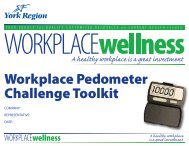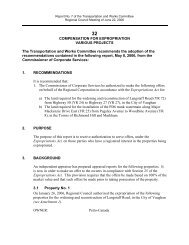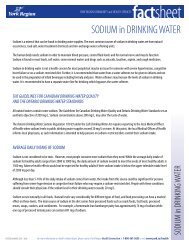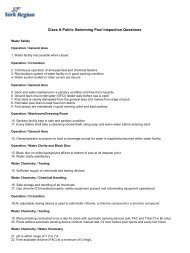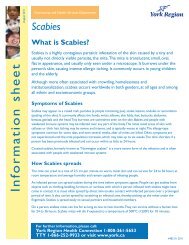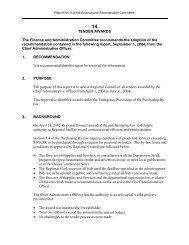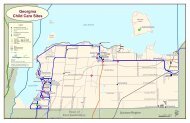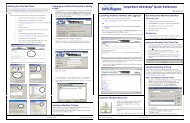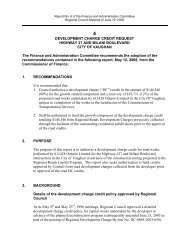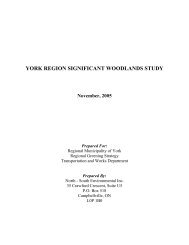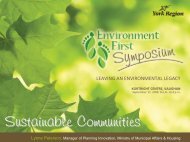Changing Landscapes: Recent Immigrants Living in York Region
Changing Landscapes: Recent Immigrants Living in York Region
Changing Landscapes: Recent Immigrants Living in York Region
You also want an ePaper? Increase the reach of your titles
YUMPU automatically turns print PDFs into web optimized ePapers that Google loves.
» In 2006, the percentage of recent immigrant<br />
youth (aged 15 to 24) liv<strong>in</strong>g <strong>in</strong> Markham was<br />
slightly higher than across all of <strong>York</strong> <strong>Region</strong><br />
(17 per cent vs. 16 per cent).<br />
Table 13: Age Distribution of <strong>Recent</strong> <strong>Immigrants</strong>,<br />
Markham vs. <strong>York</strong> <strong>Region</strong>, 2006<br />
Age Group Markham <strong>York</strong> <strong>Region</strong><br />
# % # %<br />
0 to 4 years 450 2.4% 1,405 3.0%<br />
5 to 14 years 2,560 13.6% 6,855 14.8%<br />
15 to 24 years 3,120 16.5% 7,410 15.9%<br />
25 to 54 years 9,905 52.5% 24,685 53.1%<br />
55 to 64 years 1,450 7.7% 2,840 6.1%<br />
65 and over 1,375 7.3% 3,270 7.0%<br />
All Ages 18,860 100.0% 46,465 99.9%<br />
Note: Numbers do not add to 100% due to random round<strong>in</strong>g procedures.<br />
Source: Statistics Canada, 2006 Census, Custom Tabulations.<br />
» In 2006, 88 per cent of all recent immigrants<br />
liv<strong>in</strong>g <strong>in</strong> Markham were members of a visible<br />
m<strong>in</strong>ority group, compared to 72 per cent <strong>in</strong><br />
<strong>York</strong> <strong>Region</strong>. Markham had the largest<br />
proportion of recent immigrants who were<br />
members of a visible m<strong>in</strong>ority group among<br />
the five local municipalities be<strong>in</strong>g profiled.<br />
» The most common visible m<strong>in</strong>ority groups of<br />
recent immigrants who lived <strong>in</strong> Markham <strong>in</strong> 2006<br />
were: Ch<strong>in</strong>ese (43 per cent), South Asian<br />
(33 per cent) and Korean (six per cent).<br />
Table 14: Visibile M<strong>in</strong>ority Groups of <strong>Recent</strong> <strong>Immigrants</strong>,<br />
Markham, 2006<br />
Visible M<strong>in</strong>ority<br />
Group<br />
# of Visible<br />
M<strong>in</strong>orities<br />
% of Total<br />
Visible M<strong>in</strong>ority<br />
Population<br />
Ch<strong>in</strong>ese 7,070 42.5%<br />
South Asian 5,430 32.6%<br />
Korean 975 5.9%<br />
Filip<strong>in</strong>o 925 5.6%<br />
West Asian 870 5.2%<br />
Arab 340 2.0%<br />
Black 245 1.5%<br />
Southeast Asian 210 1.3%<br />
Lat<strong>in</strong> American 190 1.1%<br />
Japanese 25 0.2%<br />
Multiple visible<br />
m<strong>in</strong>ority<br />
220 1.3%<br />
Visible m<strong>in</strong>ority, not<br />
<strong>in</strong>dicated<br />
145 0.9%<br />
Total 16,645 100.1%<br />
Note: Numbers do not add to 100% due to random round<strong>in</strong>g procedures.<br />
Source: Statistics Canada, 2006 Census, Custom Tabulations.<br />
<strong>Chang<strong>in</strong>g</strong> <strong>Landscapes</strong>: <strong>Recent</strong> <strong>Immigrants</strong> <strong>Liv<strong>in</strong>g</strong> <strong>in</strong> <strong>York</strong> <strong>Region</strong><br />
66



